Would you like to know more about SEO analytics and how it can help you grow your business?
Analytics and data play a huge role in creating and monitoring impactful SEO campaigns. That’s why every small business owner or solo marketer should know how to use SEO analytics to boost their SEO.
This article will show you what SEO analytics is and how to create your analytics reports.
What is SEO Analytics?
SEO analytics is the practice of collecting and analyzing your SEO data to understand your site’s organic performance better. Effective SEO analytics reports also help you translate data into actionable insights you can use to create more impactful iterations of your campaigns.
Examples of actionable insights you can get from analyzing your SEO data include identifying:
- New opportunities to rank for high search volume keywords
- Issues that slow your site down
- Issues that increase your bounce rate
- Identifying which posts, pages, and traffic sources are driving the most organic conversions
Analyzing your SEO campaigns is crucial to helping you fine-tune your SEO so you can rank higher and drive more traffic to your site.
3 Simple Steps to Effective SEO Analytics
While it may sound like a daunting undertaking, SEO analytics is pretty simple if you know what you’re doing. And that’s exactly what we’ll show you.
So, let’s get right to it.
1. Use the Right Tools
The first step to SEO analytics is equipping yourself with the right tools. And one of the tools you can use right within WordPress is All In One SEO (AIOSEO).
AIOSEO is the best WordPress SEO plugin on the market and has been downloaded over 100 million times. Millions of savvy website owners and marketers trust the plugin to help them dominate search engine results pages (SERPs) and drive relevant traffic to their sites. This is because the plugin has many powerful SEO features and modules to help you optimize your website for search engines and users.
Examples include:
- Cornerstone Content: Use Cornerstone Content to build topical authority and improve semantic SEO right inside your WordPress dashboard.
- AI Title/Description Generator: An AI-powered tool that generates SEO titles and meta descriptions with 1-click.
- Next-gen Schema generator: This is a no-code schema generator that enables users to generate and output any type of schema markup on your site.
- Advanced Robots.txt Generator: Easily generate and customize your robots.txt file for better crawling and indexing.
- TrueSEO Highlighter: Makes it easy to spot on-page SEO issues and gives recommendations for fixing them.
- Redirection Manager: Helps you manage redirects and eliminate 404 errors, making it easier for search engines to crawl and index your site.
- Link Assistant: Powerful internal linking tool that automates building links between pages on your site. It also gives you an audit of outbound links.
- SEO Preview: This gives you an overview of your search and social snippets and general SEO so you can improve your optimization.
- IndexNow: For fast indexing on search engines that support the IndexNow protocol (like Bing and Yandex).
- Sitemap generator: Automatically generate different types of sitemaps to notify all search engines of any updates on your site.
One of the most beloved features in AIOSEO is the SEO Audit Checklist. This powerful module analyzes your website in seconds and identifies critical errors. For example, it scans for speed and performance issues affecting your site. The SEO Audit Checklist also offers recommendations on resolving the highlighted issues.
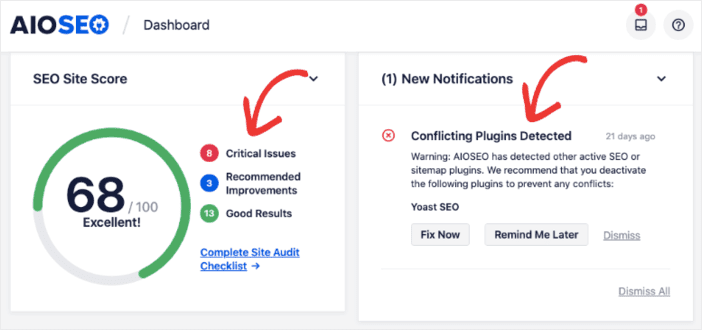
Another essential feature for analyzing your website is a module called Search Statistics. This is AIOSEO’s Google Search Console integration and gives you insights into important search metrics right inside your WordPress dashboard.
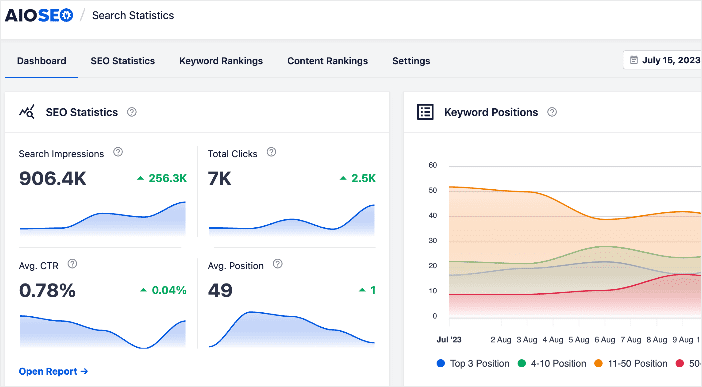
Examples of the metrics you’ll get include:
- Search Impressions
- Total Clicks
- Average CTR (clickthrough rate)
- Keyword positions
- Changes in keyword and content positions
- Page speed
- And more
These are metrics that show how you’re performing in search rankings.
With the data and insights you get from Search Statistics, you can diagnose issues affecting your website so you know what to improve on. You’ll also get insights on what’s working so you can replicate your winning strategies. As a result, you get to boost your search rankings.
For step-by-step instructions on how to install AIOSEO, check out our installation guide.
2. Know Your SEO Goals and Assign the Right KPIs
Effective SEO analysis is dependent on setting goals for your campaigns. Setting the right goals for your SEO campaigns is critical to determining what you will track, monitor, and measure as you analyze your site. Plus, it gives your campaigns a direction and target to focus on.
Once you’ve set your goals, you’ll need a way to measure whether you’re hitting them or not. To do this, you should assign key performance indicators (KPIs) to each goal. KPIs are specific, numerical metrics used to measure progress toward a defined goal. Examples of the KPIs you can use include:
These and other metrics give you an indication of your search performance. They also show you where you need to improve your campaigns.
3. Monitor, Measure, Adjust
Once your SEO campaign is running, you need to monitor and measure your performance based on the goals and KPIs you’ve set. There are many SEO monitoring tools you can use for this to make everything easier. For example, you can use AIOSEO’s Search Statistics to monitor your important metrics and measure your SEO performance.
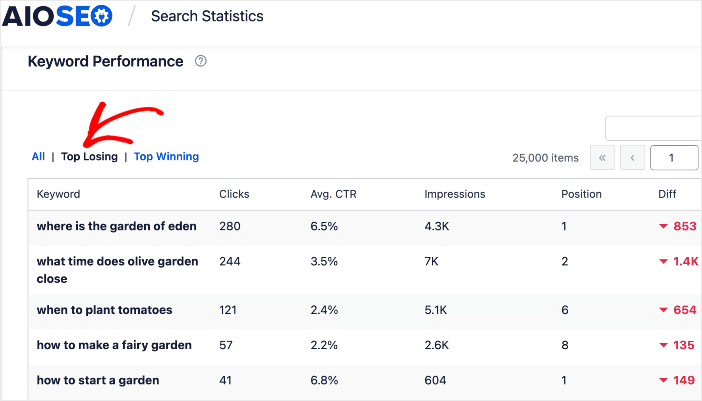
If the data in the report shows that you’re not hitting your goals, you can use it to figure out how to adjust your campaigns, so they perform better.
Elements to Include in Your SEO Analysis
SEO analytics is not just an issue of looking at random metrics. To be impactful, you must approach it strategically by analyzing specific elements of your SEO campaigns. Let’s briefly look at the top ones:
Analyze Your Content Performance
Content analysis is one of the first things to do when performing an SEO analysis. This is because your content is the foundational piece of your strategy. You can easily check your content performance using AIOSEO’s Google Search Console integration called Search Statistics.
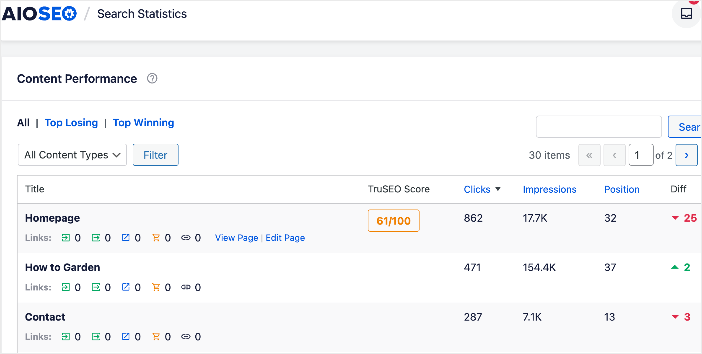
Search Statistics shows at a glance which of your pages and posts are improving in search rankings and those which are dropping. This report helps you gain insight into the type of content your target audience loves. As a result, you can replicate it and drive more traffic to your site.
If you notice pages dropping in rankings, you can analyze each page to see what to improve. A few tips for doing this include checking the following:
You can also use some on-page SEO tools to help ensure your pages are properly optimized.
Technical SEO Analysis
A technical SEO analysis is another important aspect of SEO analytics. This means auditing the technical aspects of your website that affect your performance, speed, and user experience. For example, you can use AIOSEO’s Search Statistics module to check your page load speed:
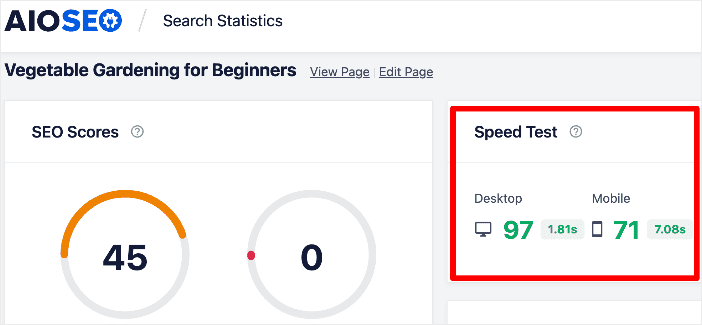
If your pages have a poor speed test score, follow these tips to help improve your page load speed. Other elements to consider include the following:
For more tips on nailing this aspect of SEO analytics, check out our technical SEO checklist.
Analyze Your Off-page SEO
Off-page SEO refers to the strategies you take away from your website to impact your rankings on SERPs. Typical examples of what’s involved in off-page SEO include:
Your off-page SEO analysis should include metrics from all the above off-page SEO strategies. You can use tools like MonsterInsights, Ahrefs, Semrush, etc., to check your off-page SEO performance and metrics.
Check out Your Competitors
Another important aspect of SEO analytics is checking out how your competitors are performing. To do this, you should conduct a competitor analysis. To get started, you should compile a list of your top competitors. Next, you can use AIOSEO’s SEO Analysis tool to check their SEO. Then, simply input your competitor’s URL in the Analyze Competitor Site tab.
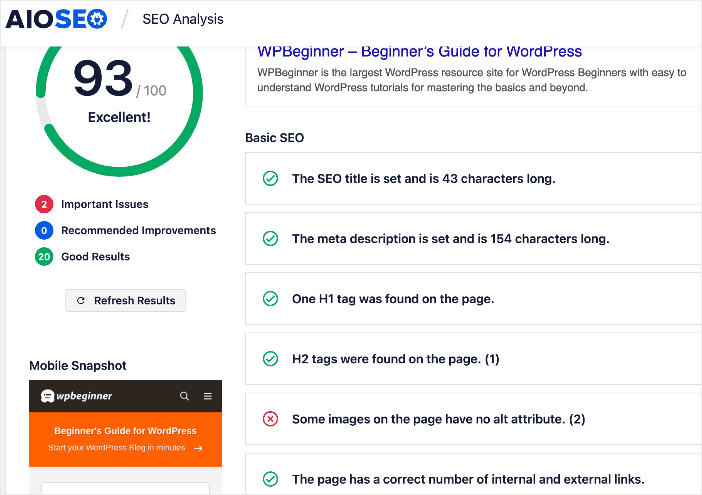
The SEO Analysis tool will give you insights and data on your competitor’s SEO. It will also show you their errors and offer recommendations on how to solve them. Of course, you won’t mail them to offer unsolicited SEO advice. Instead, you can use this information and compare it to your site. You can also use these insights to avoid your competitors’ mistakes.
SEO Analytics for Small Businesses: Your FAQs Answered
What is SEO analytics, and why is it important for small businesses?
SEO analytics involves collecting and analyzing data on a website’s performance on SERPs. It is crucial for small businesses because it helps them understand how well their website is performing. It also helps in identifying areas for improvement and making data-driven decisions to boost their online visibility and attract more potential customers.
How can small businesses get started with SEO analytics?
Small businesses can start with free or paid SEO analytics tools like All In One SEO (AIOSEO), Google Analytics, Google Search Console, etc. These tools can help track website traffic, keyword rankings, and user behavior.
How can small businesses improve their SEO performance based on analytics data?
Small businesses can improve their SEO performance by identifying underperforming content, optimizing keywords, fixing technical issues, building quality backlinks, and creating valuable, relevant content. Insights from an SEO analytics plugin like AIOSEO can guide these actions.
SEO Analytics: Secret to Outranking Your SEO
SEO analytics is an essential part of implementing and running impactful SEO campaigns. If you’re struggling to boost your rankings and outrank your competitors, this could be the secret sauce to doing so.
We hope this post helped you learn what SEO analytics is and how to use it to boost your search engine rankings. You may also want to check out other articles on our blog, like our guide on monitoring the impact of Google Algorithm updates in WordPress and our tutorial on spotting and combatting content decay.
If you found this article helpful, then please subscribe to our YouTube Channel. You’ll find many more helpful tutorials there. You can also follow us on X (Twitter), LinkedIn, or Facebook to stay in the loop.



